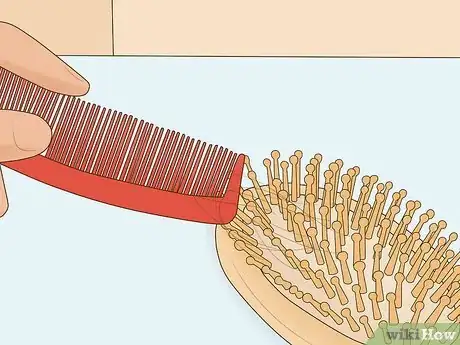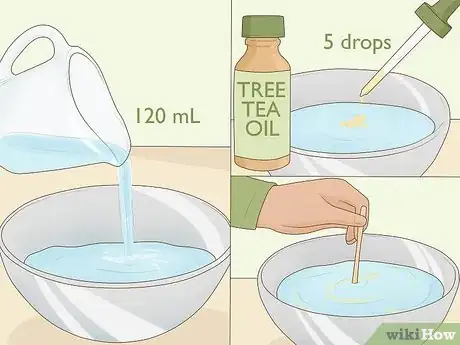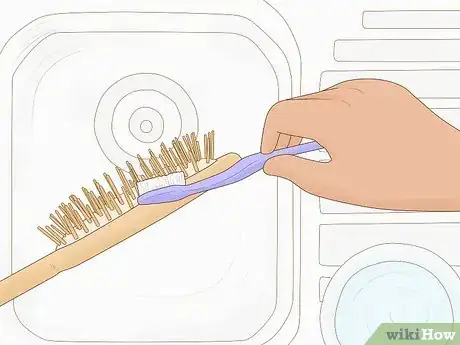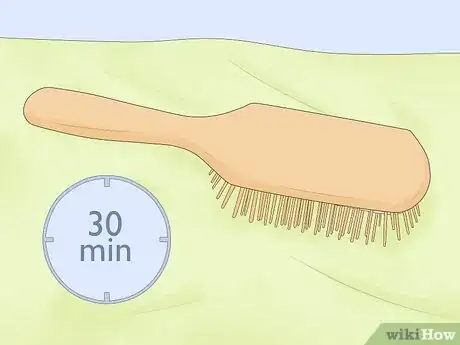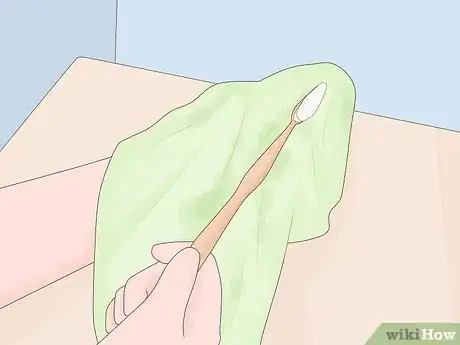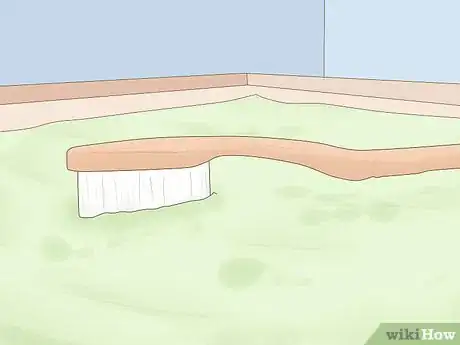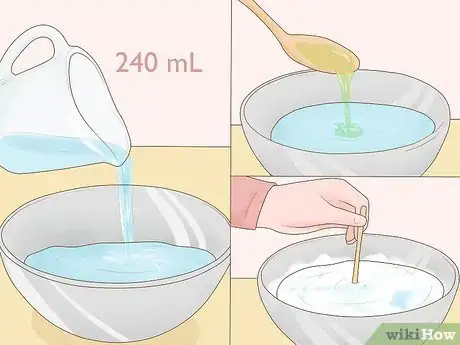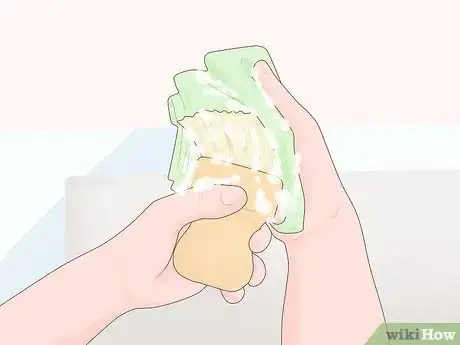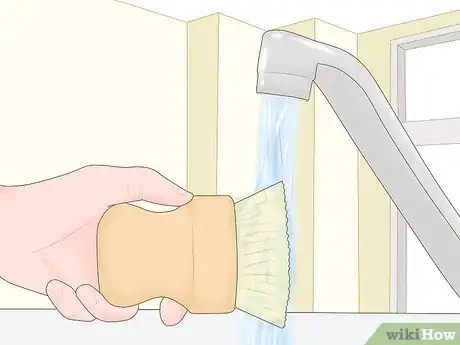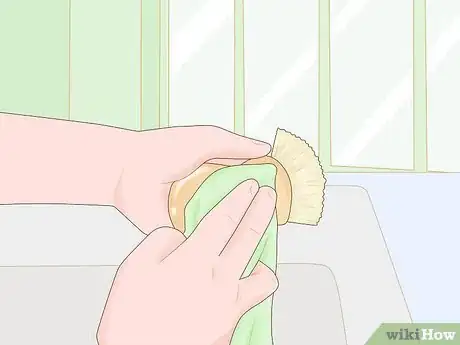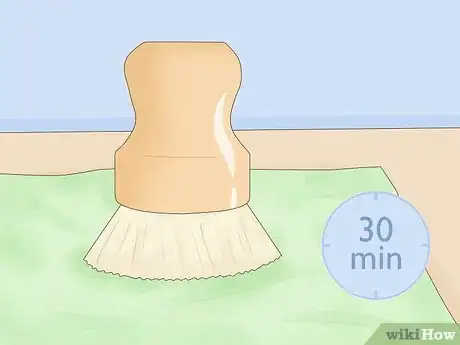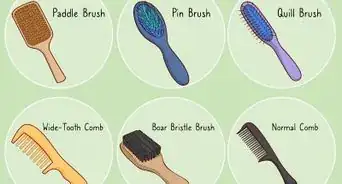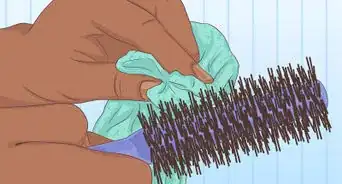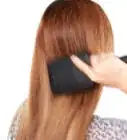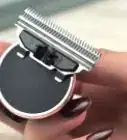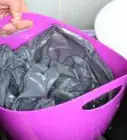This article was co-authored by wikiHow Staff. Our trained team of editors and researchers validate articles for accuracy and comprehensiveness. wikiHow's Content Management Team carefully monitors the work from our editorial staff to ensure that each article is backed by trusted research and meets our high quality standards.
There are 14 references cited in this article, which can be found at the bottom of the page.
This article has been viewed 15,397 times.
Learn more...
If you’re tired of your old plastic brushes, bamboo brushes are a way to replace them with something more eco-friendly. Made from a type of plant, bamboo brushes are comfortable to use like wood brushes and long-lasting like plastic brushes. They are also easy to clean under running water. However, they have to be dried out afterward to avoid warping or rotting. Whether you have a bamboo hairbrush, toothbrush, or kitchen brush, you can keep it bacteria-free without sacrificing its quality.
Steps
Cleaning a Hairbrush
-
1Use a thin comb to pick out any hair caught in the brush. For instance, use a rat-tail comb. Sweep it between the bamboo brush’s bristles, then pull it up. It will catch some of the hair strands. Pull them off, throw them away, then keep using the comb to remove more of them.[1]
- You could also use something small and sharp, like a bamboo skewer or the tip of a scissor blade, to pull up hair.
- Remove as much hair as you can. It becomes much harder to clear off after you wet the bristles, and leftover hair makes the brush less effective the next time you use it.
-
2Mix hot water with tea tree oil in a small bowl. Fill the bowl with about 1⁄2 cup (120 mL) of hot water. Then, add about 5 drops of tea tree oil. Stir the tea tree oil in to create a disinfecting cleaner that you can use without getting the brush very wet.[2]
- Tea tree oil is great on wood brushes since you don’t have to rinse it off much afterward. Your brush will be clean, but it will also stay pretty dry.[3]
- Another option is to mix about 1 tablespoon (15 mL) of a mild soap, such as baby shampoo, into the water. Rinse it off of the brush afterward.
Advertisement -
3Scrub grime off of the brush using an old toothbrush. Dip the toothbrush into the hot water, then use it to clean off the bristles first. Hold your hairbrush over a sink or garbage bag as you clean it. Scrub from the base of the brush to its top end, being gentle to avoid damaging any of the bristles. Then, scrub the brush’s back and handle if they need to be washed too.[4]
- You could also work the cleaner between the bristles by rubbing them with your fingers. Try using a soft, clean cloth to scrub the handle.
- If you’re having trouble cleaning debris out from the bristles, fill a spray bottle with some of the tea tree mixture. Lightly mist the bristles to soften them. You could also wipe them with a cloth dampened in the mixture.
-
4Rinse the brush by spraying it with a light amount of clean water. Fill a spray bottle with warm water, then apply a very light amount of it to the brush bristles. Wipe them off with a clean cloth afterward. For the rest of the brush, dampen the cloth in warm water, then use it to scrub off any remaining debris or oil.[5]
- Check the brush over to make sure it’s clean. If you used soap and water, the brush may require some additional rinsing to wash off the soap.
- If you applied too much water, pat the brush to remove it. Eliminate as much of the moisture as possible to ensure your brush lasts long-term.
-
5Lay the brush bristle-side down on a clean towel to dry. Spread the towel over a flat surface, like a table or countertop. Choose a spot that is out of direct sunlight but has good air circulation. Then, place the brush on top of it and wait. It should be completely dry within 15 to 30 minutes.[6]
- Store the dried brush in a safe, clean spot, such as a small countertop basket or a hanging basket on your door.
- Repeat the cleaning whenever your brush starts to look a little dirty. If you clean it about once every 2 weeks, it can last a long time.
Rinsing a Toothbrush
-
1Rinse the brush under running tap water. Turn on the tap so a light stream of water is flowing from it. Hold the bristles underneath the water to clean them. Try to avoid getting any water on the brush’s handle. Make sure all of the toothpaste and other debris is gone before continuing.[7]
- Wash off your brush thoroughly after each use. Any debris left on it will become harder to remove over time and could damage the bristles.
- If you end up bending any of the bristles, gently push them back into place. Sometimes they can get bent while you’re brushing or washing them, but they are unlikely to break.
-
2Pat the brush with a clean towel to remove excess moisture. Your brush will likely be pretty wet after you rinse it off, but water exposure isn’t good for bamboo. To preserve your brush, thoroughly dry it as soon as you’re done cleaning it. Wrap the brush’s head in the towel and wipe it off gently. Also, wipe off the handle if it got wet.[8]
- Since bamboo absorbs moisture, limiting its exposure to water helps preserve it. Try to remove the water right away so it doesn’t have a chance to sink into the brush.
-
3Lay the brush on a towel or another flat surface to dry. Spread a towel out over your countertop, then place the brush on top of it. Turn it so the bristles are face down. Any moisture left over will drip onto the towel instead of lingering on the brush. To ensure your brush lasts as long as possible, dry it off this way after each use.[9]
- You could lay the brush on any flat surface, but it’s best to put a towel under it to absorb the remaining moisture.
- If you have a good toothbrush holder, stand the brush up in it to dry. As long as it holds the brush at an angle, the water will be able to drip off the bristles without soaking the handle.
-
4Wait about 30 minutes for the brush to dry before storing it. Leave it out in the open until it feels completely dry to the touch. Then, you can move it into a cup, toothbrush holder, or another spot. With proper washing and drying after each use, your brush will stay clean and in one piece.[10]
- Bamboo toothbrushes last as long as plastic ones when cared for properly. However, dentists recommend changing your brush out every 3 months to prevent bacteria from growing around the bristles.[11]
- Bacteria is more likely to grow on your brush when it’s in an enclosed, humid spot. Leaving it out in the open is fine, but put it in an enclosed case for protection when you need to take it with you.
Deep-Cleaning a Dish Scrubber
-
1Mix a mild dish detergent into a bowl of hot water. Fill a bowl with about 1 cup (240 mL) of hot water. Then, choose a non-abrasive dish soap and pour up to 1 tablespoon (15 mL) into the bowl. Stir until the water is soapy.[12]
- Your regular dish detergent is more than enough to clean a bamboo scrub brush in most cases. Avoid detergents that are designed to cut through grease or have strong chemicals in them.
- If you’re looking for a safe soap to use on bamboo, try a neutral-pH dish detergent.
-
2Use a moist cleaning cloth to wipe debris off of the bristles. Dip the cloth into the soapy water to dampen it. Then, scrub along the bristles from the handle to the brush’s top. Finish by wiping the back of the brush and its handle if those spots also need cleaning.[13]
- To remove stubborn debris, scrape it off with a fork. You could also use an old toothbrush to help get between the bristles.
- Clean off as much debris as possible to keep your brush in good condition. Removing old food is important for preventing bacterial growth.
-
3Rinse the brush clean under running water. Run warm water in a sink. Use it to wash away the soap and any remaining debris. Try to limit how much water gets on the brush’s handle, but make sure the bristles are as clean as you can get them. If they still look dirty, treat them a second time with soap and water.[14]
- To limit how much water the bamboo absorbs, dampen a cloth in warm water, then use it to scrub the bristles clean.
- To keep your brush in good shape, wash it off after each use. If you’re able to, clean it before food debris has a chance to solidify between the bristles.
-
4Pat the brush dry with a clean cloth to remove excess moisture. Wipe away any water that has dripped on the bamboo. Then, wipe off the bristles. Be gentle to avoid damaging them. Remove as much water from the brush as you can to prevent the bamboo from absorbing it.[15]
- Eliminating moisture now prevents it from sinking into the bamboo. Bamboo absorbs moisture, which can cause your brush to rot or crack.
-
5Lay the brush on a clean towel to dry for 30 minutes. Find a spot out in the open with plenty of air circulation, then spread out a towel there. For instance, use a countertop next to your sink. Place the brush bristle-side down so that any water on the brush drips off of it. After 30 minutes have passed, check that the brush is dry to the touch.[16]
- Keep the brush out of direct sunlight. Too much light could cause it to discolor or crack.
- The brush should be completely clean and dry. If it isn’t, clean it a second time to ensure it stays in great condition.
-
6Soak the brush in vinegar if it has stains you can’t wash out. Sometimes bamboo scrub brushes require extra treatment, so get a clean bowl and fill it with about 1 cup (240 mL) of vinegar. For a little extra strength, mix in a drop of a mild dishwashing detergent. Then, soak the bristles for 1 hour. Wash and dry the brush afterward to keep it in working order.[17]
- You could also use a few drops of tea tree oil in place of the detergent. Tea tree oil is good as a natural cleaner and can neutralize part of the unpleasant vinegar smell.
- A bamboo brush may need deep-cleaning once every 1 to 2 months. It depends on what kind of condition the brush is in.
Warnings
- Bamboo absorbs water, so allowing it to soak could ruin it. Treat your brush gently, but keep it clean to ensure it lasts longer.⧼thumbs_response⧽
Things You’ll Need
Cleaning a Hairbrush
- Rat-tail comb, skewer, or an alternative pick
- Bowl
- Baby shampoo or neutral detergent
- Spray bottle
- Towel
Deep-Cleaning a Dish Scrubber
- Bowl
- Dish detergent
- Clean cloth
- Fork or an alternative pick
- Towel
- Vinegar
Rinsing a Toothbrush
- Towel
- Toothbrush holder or alternative storage
References
- ↑ https://www.youtube.com/watch?v=0I43vMjfUzU&feature=youtu.be&t=346
- ↑ https://www.southernliving.com/fashion-beauty/hairstyles/how-to-clean-hairbrush
- ↑ https://www.ncbi.nlm.nih.gov/pmc/articles/PMC1360273/
- ↑ https://www.youtube.com/watch?v=_A1RrZvlN5U&feature=youtu.be&t=140
- ↑ https://www.youtube.com/watch?v=T680KTT9NgE&feature=youtu.be&t=215
- ↑ https://www.youtube.com/watch?v=T680KTT9NgE&feature=youtu.be&t=229
- ↑ https://www.cdc.gov/oralhealth/infectioncontrol/faqs/toothbrush-handling.html
- ↑ https://www.youtube.com/watch?v=QTkaMwf8lZg&feature=youtu.be&t=6
- ↑ https://www.cdc.gov/oralhealth/infectioncontrol/faqs/toothbrush-handling.html
- ↑ https://www.cdc.gov/oralhealth/infectioncontrol/faqs/toothbrush-handling.html
- ↑ https://cchp.ucsf.edu/sites/g/files/tkssra181/f/ToothbrushCareEN050106.pdf
- ↑ https://www.youtube.com/watch?v=F9gq4QmichE&feature=youtu.be&t=322
- ↑ https://content.ces.ncsu.edu/washing-and-sanitizing-kitchen-items
- ↑ https://www.youtube.com/watch?v=XGFmH9yIasM&feature=youtu.be&t=60
- ↑ https://content.ces.ncsu.edu/washing-and-sanitizing-kitchen-items
- ↑ https://www.thekitchn.com/how-to-clean-and-disinfect-a-dish-brush-229505
- ↑ https://www.thekitchn.com/how-to-clean-and-disinfect-a-dish-brush-229505
- ↑ https://blogs.ei.columbia.edu/2019/11/11/plastic-industry-greenwashing/
